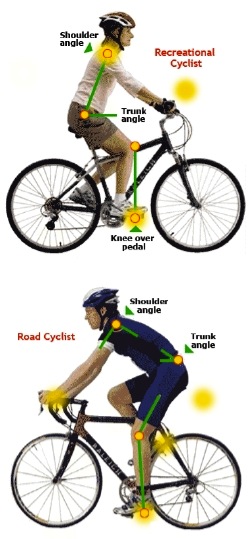But for a few exceptions, indoor cyclists should simulate the hand positions that an outdoor cyclist utilizes. Those exceptions would be the very aggressive riding positions of elite cyclists and triathletes utilized during competitions, reserved for athletes with many years of skills, fitness, flexibility and of course, the tens of thousands of dollars to pay for fine-tuned, custom fitted bicycles. For the rest of us mere mortal cyclists, where you put your hands outdoors is where you want to put them idoors. Many decades (one might even say over a century) of research has gone into determining the optimal riding positions and measurements for cyclists; positions that take into consideration comfort, injury potential, optimal transfer of forces to the drive train and performance enhancement. (Note that aerodynamic is not a consideration indoors). Indoor cycling instructors and enthusiasts should respect the knowledge that is provided from the cycling world, even (or especially) if you or your students do not ride bicycles outside.
 Therefore, before we discuss where you should put your hands when riding indoors, let’s look at what a cyclist does. Your comfortable riding position outdoors begins with the first day you buy your bicycle.
Therefore, before we discuss where you should put your hands when riding indoors, let’s look at what a cyclist does. Your comfortable riding position outdoors begins with the first day you buy your bicycle.


I finally got around to reading this article and I have to say greattiming. I have an introductory class with some very short (verically challenged) and some very tall riders. The bikes in the studio do not have adjustable handle bars and I was at a loss as what to suggest to these “other than average” riders. Now I know!
Keep up the great work!
on HP 1: I wonder why some programs still advocate or even mandate HP1 with hands closed in the center of the bar … I am aware that some experienced (mostly triathlon) riders can ride in this position still relaxed and efficiently, this is why I allow HP1 and HP2 on par.
on HP 2.5: on indoor cycles the bar’s lateral elevation is often not suficcient resulting in over-bending the wrist while sitting and holding on the lateral part of the bar. Holding the bar in the “corner section” allows a more natural position. Perhaps you want to add a picture on this ?
Fantastic article Jennifer. Makes excellent sense.
Thanks so much for pulling apart some old ideas and giving us the facts.
clair
It is always awesome how much you can write about “simple” stuff. But we see, it is not that simple 😉 Great work you did.